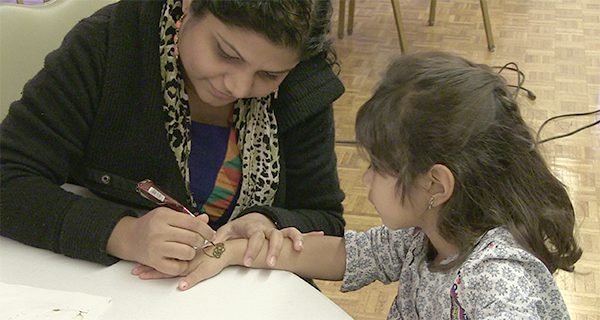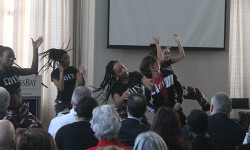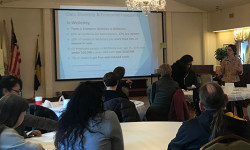[ccfic caption-text format="plaintext"]
By Rama K. Ramaswamy
The World of Wellesley (WOW) and the Wellesley Community Center (WCC) were the primary sponsors for the 2016 Diwali program held at the WCC last month.
Members of the Wellesley Indian community, Manisha Varma, Rimi Chaudri, Marguerite Chatalier and WOW President Michelle Chalmers decorated the room already lit by glittering chandeliers with rows of lights, one-of-a-kind fabrics, samples of Indian festival cuisine, music, and multicultural conversation.
“Diwali” or “Deepawali” is India’s biggest and most widely celebrated festival of the year. The celebration gets its name from the rows of clay lamps that are lit outside homes, businesses and other public sites to symbolize nurturing one’s inner light that keeps one from spiritual darkness. For an oil lamp to burn, the wick has to be both above and below the oil, just as each person should remember to be part of the material world, yet not be drowned by it; if one is consumed by materialism, one cannot bring joy and knowledge into one’s life. The Hindu belief is that by lighting the lamp of wisdom, one can light up often easily buried or forgotten values; by acquiring knowledge, one can awaken all the facets of one’s being. Furthermore, the custom is not to be satisfied with lighting just one lamp, but rather, thousands of lights - for many are needed to dispel the darkness of ignorance.
Members of the Wellesley Indian community said that sharing sweets and gifts symbolize the dispelling of bitterness and renewal of friendship. The Diwali celebration includes the spirit of service. Hindus believe that in sharing and in giving, we receive.
Diwali is celebrated in October or November each year (following the lunar calendar’s changing dates) and originated as a harvest festival that marked the last harvest of the year before winter. India was largely an agrarian society in which people would seek the divine blessing of Lakshmi, the goddess of wealth, as they closed their accounting books and prayed for success at the outset of a new financial year. Today, this practice extends to businesses all over the Indian subcontinent, which marks the day after Diwali as the first day of the new financial year.
Indians traditionally celebrate with family gatherings, glittering clay lamps, festive fireworks, strings of electric lights, bonfires, flowers and the sharing of sweets following lavish feasts. Some believe that the Goddess Lakshmi wanders the Earth looking for homes where she will be welcomed, therefore festival partakers open up their doors and windows, and light as many lamps as they can find to invite her in.
Over the centuries, Diwali has become a national festival that is enjoyed by most Indians regardless of faith: Hindus, Jains, Buddhists and Sikhs. This is a festival that is also celebrated over five days, each day with specific designated activities such as reuniting with siblings, spring cleaning, and gathering with family and friends to enjoy a lavish meal.
Highlights of the gathering at the WCC included a “sari” wearing, fashion demonstration, and an interactive presentation by Manisha Varma. Attendees discussed history, culture, shared stories of multicultural traditions and discovered “how much we all have in common.” Watch the event documented by Wellesley Media at https://youtu.be/XqZcOJSK5Jo.























